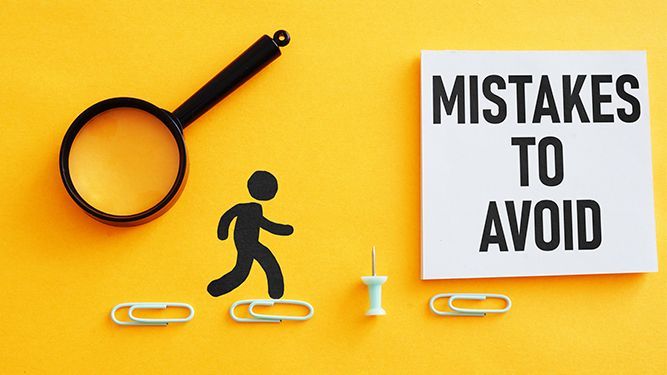Advisor Answers

This article was originally written by Matt for BizBuySell: https://www.bizbuysell.com/learning-center/article/avoiding-mistakes-when-selling-business/ As a business owner, you may someday intend, or hope, to sell your business. You’re always busy either running the business or with life in general, which means selling your business is likely not at the forefront of your mind. It’s common for owners to not think of, or prioritize, exactly how they are running their business and the decisions they make that can either add or detract from the business’s value. They’re often on autopilot, too focused on hammering nails to see what they’re building, majoring on the minors. Before they know it, it’s time to sell, whether by choice or not, and they haven’t taken the necessary step back to understand what, if any, value they’ve created for themselves. Creating a valuable business should be a top priority for every business owner, whether or not they ever intend to sell. Why? Because aside from how much money a business makes, a well operated, balanced, and documented business is not only worth more, it’s much easier and enjoyable to run. An owner should attempt to always have their business operating in such a state, not only for efficiency and maximum earnings, but you never know when a desire or reason to sell may arise. Some aspects of a business could take years to adjust. Others can be done in the shorter term. 15 Mistakes Business Owners Can Address Now for Future Success 1. Selling in a Rush Selling your business in a rush can force you to lose leverage. There may be several reasons beyond your control that have you in a time pinch to sell. Having your business prepared for a sale at all times can help minimize any time pressure to accept sub-par terms or price. Patience can be one of the most effective negotiating tools. Allow yourself enough time to ensure you’re choosing the best buyer available. Plan, plan, plan. 2. Selling When Business is Down The last three years of business performance are critical to a buyer’s perception of the business’s value. A continuous downslope can be hard to merit a seller’s desired value. Naturally, when anything negatively affects the business or the industry the business is in, and then you look to sell, it can come with a hefty discount. If possible, sell when business profits have been on a regular increase for perhaps 2-3 years and operations have been in a steady place. Too often owners think about selling when something bad happens and they do not get nearly as much as they hoped. 3. Attempting to Time a Sale With the Market The stock or general economic market should have little to no bearing on when you decide to sell your business. If you’re able to sell at a perceived premium because of market health, you’re using the same sale proceeds to invest/spend that money at the same premium market price for stock, real estate, or another business. The value of a good business should have little to no fluctuation with the larger external economy, and could sometimes be worth more in a down market. Naturally there can be exceptions for businesses in industries whose revenue tends to fluctuate with the economy [restaurants, travel, leisure, etc.] but a consistent history, a good broker, and a savvy buyer can help mitigate that. 4. Having Commingled Books or Taxes It’s not uncommon for business owners to combine business or personal funds/taxes into the same entity. This makes it very difficult, if not impossible, to separate revenue and expenses between the businesses, and for an acquirer to be comfortable with the numbers. Keep unrelated entities separate if you ever desire to sell one of them. 5. Being a Point of Contact with Customers or the Face of the Business If your customers do business with your business because of you, the business is too dependent on you. As an owner, take yourself away from customer interactions and delegate that to a salesperson/account manager. Otherwise, a buyer will see those relationships with a low level of transferability. In the same thread, as much as some owners enjoy being the face of a business, it’s hurting the business’s value. Buyers may not see Joe Smith’s Driving School as having any value without Joe Smith. 6. Having any Single Customer or Client Make up More Than 10% of Your Revenue If any single customer makes up 10% or more of your business’s revenue, a buyer would be worried if that customer were to leave after a sale and decrease revenue by 10% or more. It’s not always easy or possible, but add enough customers and diversify to decrease dependency on any single or small group of customers. If customer concentration is too high, a seller may only get incremental portions of revenue after a sale, conditioned on those customers remaining with the business after closing. 7. Ignoring Issues You Need to Address You can’t ignore them away. An issue, whether externally or internally, that has been a challenge or that you see coming will arise in either a due diligence process, training period, holdback, earnout, or even a lawsuit. Be honest with yourself, your sales advisor/broker, and buyer. There may be a simple fix, reference, or term to consider prior to listing and negotiation that can save you a lot of time, money, and headache. 8. Not Allowing Enough Time to Prove any Major Changes Were Effective It is very common for business sellers to make a major change to the business in the time leading up to a sale and assume a buyer will understand or be confident in the decision. The truth is, buyers (and lenders) want to see a history of consistency with a business’s offerings and operations to perceive value. Just because you fixed or added something to the business that improved revenue/profit six months ago, doesn’t mean it’ll immediately add a significant price jump. Conversely, don’t cut necessary expenses for long-term operations for better perceived short-term margins. It will be noticed and can decrease the value. 9. Not Knowing the Total Costs of a Sale with Taxes and Fees The sale of a business can be taxing in more than one way. Once you’ve had an advisor conduct a realistic valuation on your business, consult your tax professional and financial advisor regarding your tax and larger financial responsibilities. Before making major financial decisions on your future, know what your business might be worth. Decisions could prove irrelevant if you don’t know the facts. Don’t let incorrect assumptions about taxes, fees, or your business’s value lead to poor retirement planning or business decisions. 10. Assuming You Know How a Sale Will Go The sale of a business rarely goes how everyone expects it to. You may get a price you hope for, but the process itself often takes longer than expected, along with aspects that weren’t expected but are usually surmountable. Having a good combination of optimism, flexibility, and perspective will get you to a close. If you’ve hired a good sales advisor, they should be helping you foresee and overcome any challenges, providing you with information and options to make the best decisions for yourself. 11. Telling Everyone You Want to Sell 99% of the time don’t tell anyone! Except your spouse, certain family, and trusted advisors. Telling people such as customers, employees, or vendors opens them, and you, up to a world of uncertainty, pessimism, anxiety, and problems that are usually not merited. Issues are often more quickly overcome once a deal is done. Having the wrong people know about a potential sale can hurt your buyer and thus the business’s value. There can be specific cases when it makes sense, or may even be required, to tell people outside your ‘circle of trust’, but ensure you fully understand those reasons and the pros and cons. 12. Assuming You Can Start a Similar Business After You Sell It may be obvious to some, but sometimes sellers don’t realize they cannot open a similar or same business after a sale. If you sell a business in an industry, a buyer will require a non-compete in that industry or geographic market. A common period is five-10 years. Keep in mind this can apply to any customer, vendor, or even employee overlap, depending on the circumstance. If your plan was to restart after a sale, revisit the plan. 13. Being Dependent on One or Few Suppliers or Service Providers There can be exceptions to this with long term, transferable, or new contracts put in place. Since such contracts are not as common, having one or a few suppliers is not desirable and risky for buyers. If possible, ensure there’s a quick and solid backup plan if that supplier were to disappear. Regardless of how much you’re making, if you’re simply a retailer for a unique product or service, if someone else can use the same supplier in the same market, your business may have little to no value. The competitive risk for a product or service with a low barrier to entry may be too great. 14. Attempting To Do It On Your Own Selling your own business yourself could make sense if it's small, the money is not a concern to you, and you're doing it with someone you know and trust very well. Even that can be riddled with problems and has low success. Using an advisor/broker will help ensure you’re getting a maximum price from a large buyer network. There are many potential terms, issues, and problems that can arise when selling a business. Even seasoned professionals don’t always get it right. Use an experienced advisor to protect yourself and get the most value. 15. Not Hiring Professionals That Specialize in Business Sales/M&A I’ve seen many either real estate or commercial brokers attempt to sell businesses unsuccessfully. There are some that do both, but ask enough of the right questions to ensure they’re well versed in business sales. Business sales have a world of differences and complexities from real estate sales, which is why the fee is higher. I’ve also never seen a generalist attorney that didn’t specialize in business sales help close a transaction. Although I’m sure it’s happened at some point, there are many unique legal norms, terms, and language that needs to be known in business transactions. Ensure your counsel is versed in business sales for maximum value and a smooth process. Now you know some major critical mistakes to avoid when selling and running your business. Applying solutions and avoiding these mistakes will not only make your business more valuable later but also help you run a smoother and more sound operation now, regardless of when or if you sell. Don’t sell in a rush or when business is down. Don’t be a main point of contact for the business or ignore problems. Ensure your customers are diverse and do not be dependent on a single supplier. The sooner changes are made and the longer such changes can be portrayed as effective, the better. Lastly, hire professionals that are experienced and focused on business sales. Your future self will thank you.

This article was originally written by Matt for BizBuySell: https://www.bizbuysell.com/learning-center/article/new-priority-lag/ It’s no secret business transactions are usually quite complex and delicate processes, often involving emotions, tough decisions, and a constant re-prioritizing of objectives. The business advisor’s job is to help minimize such challenges, foresee potential issues, manage both buyer and seller expectations, and get the transaction to a close as smoothly as possible. Sometimes it is smooth, but more often than not, complex transactions require patience, a fluid perspective, and complex solutions. This common challenge is known as “New Priority Lag.” Understanding New Priority Lag New Priority Lag is the adverse, but understandable, challenge of not knowing what you don’t know about the transaction, terms, norms, the buyer, the seller, the business, the timing, prioritizing, and even yourself. This lack of awareness can significantly slow down or, in some cases, even jeopardize a deal. It’s like the Dunning-Kruger Effect but in the context of business sales. People who know little about a subject or circumstance don't have the knowledge or skills to spot their own mistakes or knowledge gaps. Simply put, New Priority Lag is the lack of knowledge that slows (or kills) deals. The Dunning-Kruger Effect in Business Sales The Dunning-Kruger Effect is a cognitive bias in which people wrongly overestimate their knowledge or ability in a specific area. By contrast, this effect also causes those who excel in a given area to think the task is simple for everyone, and underestimate their relative abilities as well. This tends to occur because a lack of self-awareness prevents them from accurately assessing their own skills. This can happen very innocently with anyone in a given area. Since business owners (sellers) and buyers (often previous business owners) tend to have had some level of success to get them to where they are, it's not uncommon for them to also have a higher level of confidence. Neither may have gone through the process of buying or selling a business, or sometimes worse, they have done it once or twice and think they know how it’s supposed to go every time. Confidence is so highly prized that many people would rather pretend to be smart or skilled than risk looking inadequate and losing face. Even smart people can be affected by the Dunning-Kruger effect because having intelligence isn’t the same thing as learning and developing a specific skill. Many individuals mistakenly believe that their experience and skills in one particular area are transferable to another. Obviously, confidence is a good thing to have, unless it’s attached to an impenetrable or fragile ego. Selling or buying a business can be humbling, and more often than not, open-minded buyers and sellers walk away having learned something about themselves, in addition to having sold or bought a business, or not. New Priority Lag is the effect in the process of a transaction that someone or everyone didn’t see, or know, to expect was coming. It will suddenly change someone’s, or the transaction’s, priorities, which will usually delay or can even kill a deal. It can be as simple as a seller suddenly realizing they aren’t ready to sell for a personal reason, or something as external as new regulations not allowing a buyer to acquire a business under the terms they intended. The Impact of New Priority Lag Even the most well adjusted, intelligent, and experienced parties in business transactions experience New Priority Lag. Business advisors serve their clients best by honestly managing expectations, being prepared for the worst but optimistic for the best. NPL is why a transaction that should theoretically take a month or two will often take a month or two longer, or more. Due diligence gets delayed because the bookkeeper is on vacation. The seller’s supplier increases prices, thus requiring a recalculation of expected earnings. The buyer’s spouse loses their job, thus changing loan qualification with the lender. Having the right attitude and patience to get past such hurdles is a required skill set to be a successful business owner. Examples of New Priority Lag Expired Patent : Seller doesn’t know their revenue-dependent patent expired, devaluing the business. Miscommunication with Family : Buyer or seller assumes their spouse/family agreed with their decision to purchase/sell a business, leading to miscommunication or no communication. Unexpected Tax Burden : Seller miscalculates the tax burden, leading to a decision to continue operating for a potentially greater future valuation, but the value actually declined Final Offer Miscommunication : Buyer doesn’t share that their first offer is their final offer, causing the seller to expect negotiation, resulting in retracted offer. Employee Exodus : Seller thought it was a good idea to tell all of their employees their intention to sell, leading to employee resignations before a transaction. Funding Source Withdrawal : Buyer thinks their funding source is solid, but the ‘friend’ had to back out at the last minute License Assumptions : Seller assumes buyer is licensed in the trade they are acquiring, buyer assumes the seller will keep their license attached to the business Post-Sale Availability : Buyer assumes the seller’s availability post-sale, but the seller is relocating. Non-competition Expectations : Seller plans to start a nearly identical business right after selling, buyer expects 10 years of non-competition Allergy Discovery : Buyer discovers he’s recently developed a shellfish allergy and backs out of the seafood franchise, buys a car wash instead Inadequate Legal Representation : Buyer’s attorney is a generalist and assures the buyer they can handle the transaction, only to find out weeks later they cannot, buyer loses opportunity Lease Negotiations : The landlord of the seller’s business requires a profound rent increase for the buyer in order to approve the lease assignment, a month is spent just negotiating new lease terms, delaying closing by a month. Managing New Priority Lag Naturally there is learning when experiencing something new, so New Priority Lag will inherently, and most likely always, be a factor in business transactions to a degree, however minor. An experienced business sales advisor will help a seller and buyer foresee and minimize such problems. Ways a buyer or seller can help minimize New Priority Lag for themselves: Self-awareness : Routinely question your knowledge base and perceptions. Be your own devil’s advocate. Seek counsel : Consult experts and seek advice from others. Honesty is key : Don’t assume problems will go unnoticed; be honest about challenges. Expect the unexpected : Anticipate and prepare for unexpected obstacles. Continuous learning : Keep yourself in a constant learning position. Emotional control : Don’t let emotion override logic. Take time to process before responding or making decisions. Experienced advisors : Hire experienced advisors, attorneys, CPAs, advisors, partners, to help with the sale of your business. In conclusion, New Priority Lag is an inherent factor in business transactions, and effective management is crucial for successful deals. Ensure you hire an experienced business advisor that can help you navigate the complex process of selling a business.

This article was originally written by Matt for BizBuySell: https://www.bizbuysell.com/learning-center/article/finance-options-down-payments/ Perhaps you are amongst the growing number of individuals who are interested in being their own boss by starting a business, or better yet, buying an already established one. Buying a business may cost you more, on average, than starting one from scratch, but aside from any tangible assets, what you’re really buying is less risk, existing revenue/customers, and a significant shortcut. In this article, I’ll be covering some common types of financing buyers utilize when purchasing a business and how much money it typically takes. So how much money do you really need to buy a business? As often answers go in business, it depends. It is more the exception than the norm that a business is purchased outright with a simple and flat cash transaction. In a market where financing options are plentiful, few deals outside of smaller asset sales are all cash purchases. In larger private equity backed deals, cash transactions are more common. SBA Financing What is often considered the gold standard for financing the purchase of a business is an SBA 7(a) loan. These types of loans are popular because they usually have competitive interest rates, are spread on average over 10 years to allow lower payments, are backed by the U.S. Small Business Administration, and typically only require about 10-12% of the transaction price as a down payment. The caveats of SBA financing, as with anything involving compliance with the government, is that the application process can take a while, 2-3 months on average, and you can only have one at a time. Some SBA lenders may be able to process it in as little as 6-8 weeks. In that application process, the lender will want to see a business plan and ensure the buyer has the skill set, knowledge, and capability to continue operating the business successfully in a manner to support the loan payments. Other aspects that come into play with SBA financing: Lease - if a business is location dependent, they will likely require the buyer’s lease to be for the life of the loan. Landlords don’t always want to commit to a 10-year lease. If the majority or all of the commerce the business conducts is remote, and the business is easily relocatable, then the location may not be an issue at all. Taxes - the revenue/income of the business being acquired must have been well documented on previous year’s taxes, ideally for at least three years. If the seller did not accurately report income, it does not matter how profitable the business was on the profit and loss statements. SBA only cares about the taxes. An experienced broker should identify this before the business goes to market. Competition from other types of financing - if a business is desirable enough, and if a seller has options, not having to go through an SBA application process with an acquirer can be an attractive alternative for a seller, leaving SBA dependent buyers by the wayside. Being an SBA pre-approved buyer does not automatically put you in a top consideration or make you a desirable buyer, but it can help. Seller Financing A second commonly utilized type of financing is seller financing, also referred to as an installment sale. This is when the seller of the business acts as the lender to the buyer of the business, usually with a significant percent of cash put down at the time of close, and the rest paid over a predetermined amount of time with interest. A common amount of cash at close is about 70-80% of the total purchase price, but it can be whatever percent is agreed upon between a seller and a buyer. I have done transactions with as little as 30% of the transaction price being cash at close, but there is risk for a seller to consider when accepting a smaller percent, which is why a lower percent is not common. Typically, at a minimum, the business itself, and its tangible assets, act as the collateral to secure the buyer’s loan with the seller. If the buyer were to default on their obligation, the seller then has legal grounds to reclaim the business and its assets through court proceedings. Since online or service-based businesses typically have little to no tangible assets near the value of the amount loaned, a seller may require additional collateral, such as a buyer’s real estate, another business, or some other form of security. Seller financing can be an attractive option for both a buyer and a seller for several reasons. SBA Alternative - if a business does not qualify for an SBA loan, and the buyer does not have enough cash, but the seller is confident in the buyer, it can be a great alternative. Taxes - a seller can spread their tax burden over several years and keep the income in a lower bracket. Always consult your tax professional. Interest - a seller can offer a competitive interest rate to a buyer, compared to an SBA loan, and collect interest on the financed portion of the sale they would otherwise not receive in an all cash sale. Payment Efficiency - prior to closing the transaction, the buyer and seller agree to a set payment schedule and can thus plan their future income/expenses. As opposed to another type of financing structure with fluctuating payments that I’ll get into next. Earnout A third common financing structure is called an earnout. It is similar to seller financing only in the sense that there is usually a portion of the consideration in cash at the execution of the transaction, with the rest paid over time with agreed upon conditions. Commonly, it is a percent of revenue, not profit, since profits are more easily manipulated, and paid quarterly until either a balance is paid or a time period has expired. Since it is a percentage of the revenue and not a fixed amount, payments can vary widely or be nothing for certain periods. Earnouts can get very complex and are typically preferred more by the buyer than the seller, but a seller may have the motivation to require it as well. The amount of money a buyer may need in an earnout structure can also vary widely, and depends on the reason for the structure. There can be scenarios with little to nothing down for what may be considered a high-risk acquisition, or as much as 90%+ down when only mitigating risk for a specific scenario or loss of a customer. Here are common reasons, with oversimplified term solutions: Customer Concentration - if a business has a customer that makes up a significant amount of its revenue (say 15%+), there is an inherent risk for an acquirer to lose revenue if that customer leaves. The solution is to base a portion of the future consideration on whether that customer stays or goes. If the customer continues spending X amount with the business, payments continue at X amount. If the customer stops business or changes providers for any reason, then payments stop or are reduced by X amount. Lack of Historical Performance/Expected Future Performance - if a business is young, or just added a significant new offering, or doesn’t have enough history with a certain revenue stream, or is going through some kind of change that makes future revenue uncertain, an earnout makes sense. If a seller expects changes in progress to increase revenue and profitability post transaction, they may require a ‘bonus side’ earnout where they share in the business’s future success. Industry or Market Threats - perhaps a buyer really likes a pool cleaning business but heard pool cleaning robots will be replacing humans as early as next year. The seller doesn’t agree and thinks the robots are many many years away from replacing humans to clean pools. They agree to an earnout structure under the condition the buyer will be able to maintain X amount of customers with an average X amount price. If the acquirer cannot compete with the robots, and business drops, the remaining balance is forgiven after a certain period. Owner Dependency/Relationships - perhaps a buyer is highly interested in a business but is concerned the seller is too involved, has too many personal relationships with clients, and thus thinks the business is too dependent on the seller’s personal involvement. The buyer and seller can agree on a structure that keeps the seller involved during a one year transition period and should any of a specific list of clients leave after the sale but prior to a certain date, the total consideration is reduced by X amount. Additional Financing Options for Buying a Business Other types of financing sources can be a traditional bank loan, a home equity line of credit (HELOC), cashing out a retirement account, or simply borrowing from family/friends, amongst others. If a lack of cash is your main obstacle, SBA might be your first best option, but you may be competing with many other similarly qualified buyers. If you have a little more cash to work with than others, and depending on various factors of a business, seller financing or an earnout may be a more feasible option, if not an all cash purchase. The type, size, and terms of a business you can acquire can obviously vary widely. Here’s some examples: Example 1 - You may be able to find a cafe or coffee shop for $100K that earns the seller $60K/year, but the seller works 50 hours/week, which means you’d be working 50 hours/week, unless you identify a way to increase revenue enough to hire support, or pay yourself less. Few, if any, businesses of that size are SBA financeable. The sale would likely require all or mostly cash. A HELOC can be a good option for smaller deals, as the process is much simpler and the only collateral is the buyer’s real estate and not the business assets. Example 2 - You find an e-commerce business you love that’s earning the seller $300K/year that costs $1M, but it’s not SBA financeable because the seller’s business taxes were commingled with another business of theirs. Perhaps you have and are able to offer $600K cash at close and seller financing for the rest. Example 3 - You find a distressed/asset only sale of a pressure washing business that only costs $30K total. It includes the necessary equipment and a website, but there are no customer contracts, or employees, and the seller only worked part time and seasonally. It will then be on you to grow the amount of customers, perhaps invest additional money into advertising, and find a way to turn those assets into profit. Example 4 - You find a property management company that makes $500K/year, the asking is $2M, and it’s SBA pre-approved. You have $400K total in the bank and it's a potentially great fit with your background. You make a full price offer but don’t hear back until the seller has accepted an exclusive offer from someone else. You discover later that larger companies are acquiring property management companies like crazy and you were likely beat out by a simpler cash offer. Example 5 - Perhaps your goal is to find a business that requires the least amount of your time, makes the most money, and requires the smallest down payment. Well, get in line, that’s what everyone wants, and I don’t blame you. For a business to be absentee, or semi-absentee, it needs to make enough revenue to pay full-time management, and still have profit left over for the owner. There is a reason why those businesses cost the most and have the most competition between acquirers, they’re in demand. In conclusion, there are many ways to finance many kinds of businesses with various amounts of money. If I could share a summative bit of advice for a first time buyer, it would be to know the size and kind of business you’re looking for and what your financing options are, while at the same time being open-minded to the process, and sincere about your limitations and expectations. Always consult with your professional advisors, financial planner, tax professional, partner, etc., when weighing options for your business acquisition strategy.
Let’s Talk
Whether you're ready to sell your business, not sure if you and your business are ready, or simply want to learn about the process, contact me to schedule a time to discuss.






